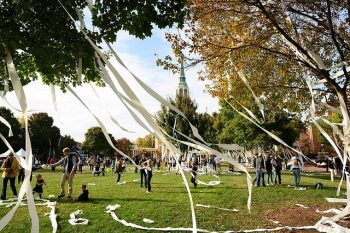I am often asked, “What do you do if you get to your studio and don’t feel inspired?” My answer is always the same: “I get to work.”

Artists cannot sit around waiting for a bolt of creative lightning to strike, or we wouldn’t get anything done. When creative work is your job, it must be approached like a job — you need to set aside time, make boundaries and show up.
Once I get started on something, anything, in the studio, I will eventually tap into a flow state and actually create. Inertia is the creative’s best friend. Cultivating subject matter is its own kind of work, and it takes practice. You have to become a sponge, soaking in what’s around you and within you that piques even a little bit of interest.
As a Wake Forest student, I was secretly convinced I had no ideas and that this would be my eventual downfall as an artist. But I look back on the works I made then and the artists and ideas I was interested in, and nearly two decades later, it’s virtually unchanged — simultaneous desire, beauty, shame, repulsion — this is what it felt like to be a woman born and raised in the South, and I am still that same person examining those same feelings.
Creative discipline is probably the hardest skill I’ve ever cultivated. When I arrived at Wake Forest in 2002, I knew I would still be within the cozy embrace of class deadlines and structure. I came to Wake Forest almost by default — I looked around at universities all over the Southeast but couldn’t find a place that seemed to put much (or any) emphasis on its art department. Then I discovered Wake Forest had something called the Presidential Scholarship for Distinguished Achievement for students with exceptional talent in art, and I decided if the University is willing to put that much funding into an art student, then this had to be the place for me.
At that time, Page Laughlin was an acclaimed painting professor and academic leader. I was nervous to begin Painting I, and rightfully so. The first assignment was one of the most painful and valuable painting lessons I’ve ever learned. We were to complete a still life painting to bring to class the following week. I worked so hard on that little painting. When we arrived, Page asked us to mix up a pile of black paint and then, to my horror, paint an enormous X across the surface from corner to corner. The point was this: Anything you did once, you can do again. And probably much better the second time. Creativity is not about a final product. It is not a bolt of lightning. It is a muscle to be torn apart and rebuilt. It is work.
I have been lucky to stay in touch with Page since I graduated and am even luckier to now call her a colleague and friend. I don’t have an easy answer for students looking to start a career in the arts; my own path was winding and difficult. But if you have a passion for creation, know that you are very, very lucky. So few have a singular, urgent dream, and the willingness to dump all of your spare time into your pursuit will inevitably yield results. Mine your life for subject matter, invest in your community of peers and take chances. Oh, and don’t forget to keep in touch with your own Page when you need a reminder to stop being precious. Now, let’s get to work!
Born in Columbia, South Carolina, Sarah Slappey (’06), is a painter in Brooklyn, New York, and is represented by Bernheim Gallery. She has exhibited in the United States and internationally. Her paintings are in the permanent collections of the Hirshhorn Museum in Washington, D.C.; the Albertina Museum in Vienna, Austria; the Pérez Art Museum Miami; the Montreal Museum of Fine Arts; the Columbus Museum of Art in Columbus, Ohio and the Institute of Contemporary Art, Miami, among others. Her work has been reviewed by Artforum, The New Yorker, T Magazine, Time Out London, Vogue Italia, Observer and Cultured magazine.


